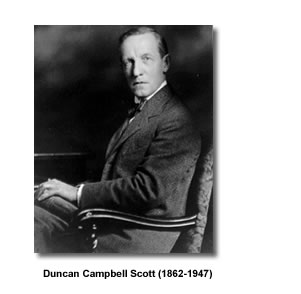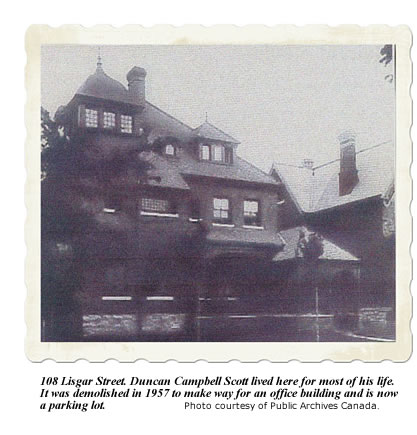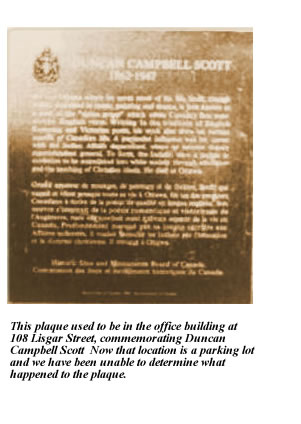DUNCAN CAMPBELL SCOTT
(1862-1947)
by Sara Jamieson
Duncan Campbell Scott was born in Ottawa to Methodist minister William Scott and his wife Janet. Lacking the financial resources to pay for the medical training that Scott wanted to pursue, his father arranged for him to be interviewed by Prime Minister John A. Macdonald, who gave him a position as a clerk in the Department of Indian Affairs. Scott’s career in the civil service would last for 52 years, culminating with his promotion to the most powerful non-elected position in his department, that of deputy superintendent general, which he held from 1913 until his retirement in 1932. Scott’s career as a civil servant affected his development as a poet in two key ways. First, it brought him into contact with Archibald Lampman who worked in the Post Office department, and who inspired Scott to begin writing poetry. Second, his job required that he make extended visits to numerous aboriginal settlements, and these experiences are the subject of what have become his best-known, and most controversial, poems.
Scott’s writings on aboriginal peoples are characterized by a fascination with aspects of Native culture that were understood to be disappearing due to the impact of European colonization and settlement; however, Scott’s regrets about the losses sustained by aboriginal peoples must be read within the context of his work for the Canadian government. Scott’s career coincided with the advent of such measures as the creation of reserves and residential schools, as well as other policies specifically intended to bring about the disappearance of aboriginal cultures by absorbing them into mainstream Canadian society. Such assimilationist policies were founded on the assumption that “primitive” Native cultures were destined to be displaced by a white society that considered itself more “civilized” and technologically advanced. Scott’s poems about aboriginal people are marked by a disquieting mixture of lament for the damage inflicted on aboriginal communities, resignation to its supposed inevitability, and fear about its possible consequences for Canada. While Scott’s official position on these issues was one of support for his government’s assimilationist mandate, in private he expressed reservations about it, and scholars continue to debate the extent of his personal responsibility for the policies he helped to implement.
The controversy surrounding Scott’s representation of aboriginal peoples reflects the vital importance of these issues to a Canadian society that continues to struggle with the legacy of colonization, but it has had the unfortunate consequence of overshadowing other aspects of his writing. Scott wrote in a variety of poetic genres, producing intensely lyrical nature poems about northern Canadian landscapes, elegiac lyrics, dream vision poems, and long narrative poems. While his theory of poetry is often anti-modernist (in a 1922 address to the Royal Society he dismissed modernism as “a virus”), he is in fact the most stylistically innovative of the Confederation poets, experimenting with the varied line lengths of free verse in poems like “Night Hymns on Lake Nipigon,” and “The Height of Land.” Like Roberts, Scott was also an accomplished writer of short stories. In the Village of Viger (1896) is a short story cycle focused on a French-Canadian village, and has been identified as a precursor to Stephen Leacock’s Sunshine Sketches of a Little Town in its affectionately ironic treatment of village life. The Witching of Elspie (1923) is a collection of tales that reflect Scott’s interest in the occult and the supernatural.
Like other poets of the post-Confederation period, Scott was dedicated to the development of a national literature. His desire to capture in his writing the particulars of the Canadian landscape and its peoples, along with his tireless support of other writers, demonstrates his belief in the important role that literature plays in the formation of national identity.
|







